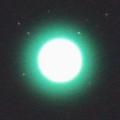
|
Great outburst occured on Oct. 24, and it bacame a naked eye comet of 2 mag. It still keeps so bright as 2.8 mag on Dec. 14 (Toni Scarmato). It was completely stellar just after the outburst, however, then a round disk like coma is getting larger gradually. The coma diameter has increased up to about 70 arcmin, and the comet has bacome very diffuse. So it looks like a huge nebula now. This comet was also in great outburst at the discovery in 1892 and became so bright as 4 mag. At that time, the comet faded after the first outburst, but soon brightened again in the second outburst. The further brightness is uncertain. But the comet will be observable in excellent condition for a while after this. It will be brighter than this ephemeris. Now it is hard to see the comet due to the full moon in late December. But after the moon disappears, it will be easily visible with naked eyes for a while in the dark sky.
Date(TT) R.A. (2000) Decl. Delta r Elong. m1 Best Time(A, h)
Dec. 22 2 58.92 45 42.4 1.864 2.675 137 4.5 20:56 (180, 79)
Dec. 29 2 58.31 44 33.8 1.943 2.704 132 4.8 20:28 (180, 80)
|
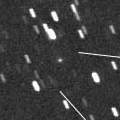
|
It will reach to 6 mag in January, and will be observable in good condition. Now it is 6.8 mag, a large bright diffuse object visually (Dec. 22, Artnovich Novichonok). The comet will move southwards very rapidly after this. But in the Northern Hemisphere, it keeps observable until early February, when it fades down to 7.5 mag. In the Southern Hemisphere, it is not observable until late December. But after that, it keeps observable until it fades out.
Date(TT) R.A. (2000) Decl. Delta r Elong. m1 Best Time(A, h)
Dec. 22 0 49.07 60 5.8 0.322 1.163 116 6.9 18:49 (180, 66)
Dec. 29 1 24.26 38 8.5 0.263 1.118 114 6.1 18:56 (180, 88)
|
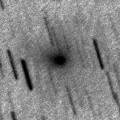
|
Now it is 10.6 mag (Oct. 14, Mike Linnolt). It is already unobservable in the Northern Hemisphere. In the Southern Hemisphere, it had been unobservable for one month since mid November. But after this, it will be observable in good condition at 10 mag until February. In the Northern Hemisphere, it will appear in the evening sky at 11 mag in March, then it keeps observable while fading gradually until May.
Date(TT) R.A. (2000) Decl. Delta r Elong. m1 Best Time(A, h)
Dec. 22 17 4.04 -50 58.3 1.712 0.983 29 9.6 5:33 (317,-22)
Dec. 29 17 2.91 -55 25.3 1.626 1.010 35 9.6 5:36 (324,-20)
|
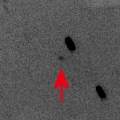
|
Brightening rapidly. Now it is 11.1 mag (Dec. 1, Marco Goiato), already bright visually. It will reach to 8.5 mag from January to March, and will be observable in good condition. In the Northern Hemisphere, it keeps observable in good condition until July when it becomes fainter than 18 mag.
Date(TT) R.A. (2000) Decl. Delta r Elong. m1 Best Time(A, h)
Dec. 22 23 7.97 -16 34.0 1.050 1.200 72 11.0 18:23 ( 23, 36)
Dec. 29 23 25.16 -13 25.9 1.033 1.160 70 10.5 18:27 ( 28, 37)
|

|
Now it is bright as 12.5 mag and visible visually (Dec. 9, Seiichi Yoshida), brightening well as expected. It will reach to 11 mag in spring. It will keep bright for a long time, however, it keeps moving in the southern sky for a while after this. In the Northern Hemisphere, it will appear at 13 mag from October to December in a short time, but very low and hard to observe. However, it will be visible visually at 11 mag in the evening sky from March to June. Then it becomes unobservable again. But it will appear in the morning sky again at 13 mag at the end of 2008, then it keeps bright and observable for a while.
Date(TT) R.A. (2000) Decl. Delta r Elong. m1 Best Time(A, h)
Dec. 22 9 50.64 -48 38.2 3.231 3.398 91 12.7 3:51 ( 0, 6)
Dec. 29 9 52.39 -49 34.8 3.137 3.359 94 12.5 3:25 ( 0, 5)
|
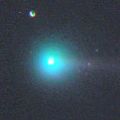
|
Already unobservable in the Northern Hemisphere, but it is observable in the evening low sky in the Southern Hemisphere. It approached down to 0.4 A.U. to the sun on Oct. 28, and it reached to 5.3 mag (Oct. 25, Juan Jose Gonzalez). Now it is fading. It has already faded down to 10.1 mag (Dec. 1, Marco Goiato). The brightening became very slow just before the perihelion passage, but it started fading rapidly after the perihelion passage. It will never be observable again in the Northern Hemisphere. But in the Southern Hemisphere, it keeps observable while fading gradually, although it will not locate very high.
Date(TT) R.A. (2000) Decl. Delta r Elong. m1 Best Time(A, h)
Dec. 22 18 3.72 -60 3.7 1.941 1.293 36 12.6 18:23 ( 36,-32)
Dec. 29 18 13.58 -61 55.5 2.041 1.415 38 13.1 5:36 (326,-32)
|

|
Now it is faint as 14.0 mag (Dec. 8, Seiichi Yoshida). It has been observable since late July, but it keeps faint in this season. It has never be brighter than 14 mag yet.
Date(TT) R.A. (2000) Decl. Delta r Elong. m1 Best Time(A, h)
Dec. 22 6 10.08 30 48.7 5.002 5.978 172 13.3 0:11 ( 0, 86)
Dec. 29 6 6.17 30 44.9 5.007 5.980 170 13.3 23:35 ( 0, 86)
|
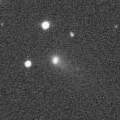
|
Now it is bright and visible visually at 12.8 mag (Dec. 8, Seiichi Yoshida). It keeps locating in good position for a while after this. But it will start fading gradually after January.
Date(TT) R.A. (2000) Decl. Delta r Elong. m1 Best Time(A, h)
Dec. 22 0 59.49 27 32.1 1.055 1.705 113 13.6 18:58 ( 0, 83)
Dec. 29 1 12.11 28 4.7 1.106 1.709 109 13.7 18:43 ( 0, 83)
|
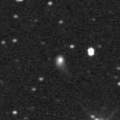
|
It is already bright and visible visually at 13.5 mag (Nov. 13, Juan Jose Gonzalez). It will reach to 10.5 mag and will be observable in good condition in 2008 autumn. It keeps observable in good condition for a long time while the comet is getting brighter slowly.
Date(TT) R.A. (2000) Decl. Delta r Elong. m1 Best Time(A, h)
Dec. 22 21 39.05 -3 14.7 4.178 3.733 56 13.8 18:23 ( 54, 36)
Dec. 29 21 45.03 -2 28.3 4.209 3.681 51 13.8 18:27 ( 60, 32)
|
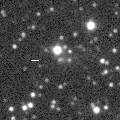
|
Now it is bright as 14.0 mag and visible visually (Dec. 8, Seiichi Yoshida). It keeps observable in good condition for a long time until spring. It will keep visible visually at 14 mag until March.
Date(TT) R.A. (2000) Decl. Delta r Elong. m1 Best Time(A, h)
Dec. 22 7 57.58 19 1.9 1.725 2.634 151 13.9 1:58 ( 0, 74)
Dec. 29 7 55.53 18 28.2 1.695 2.638 159 13.9 1:29 ( 0, 73)
|
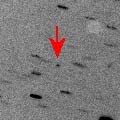
|
Now it is 14.4 mag and visible visually (Dec. 9, Seiichi Yoshida). It will be observable at 14.5-15 mag in an excellent condition until February.
Date(TT) R.A. (2000) Decl. Delta r Elong. m1 Best Time(A, h)
Dec. 22 5 11.82 30 55.7 1.534 2.503 167 14.7 23:08 ( 0, 86)
Dec. 29 5 6.33 30 7.2 1.551 2.498 160 14.7 22:35 ( 0, 85)
|

|
It was faint as 18 mag in October, but it brightened rapidly after that. Now it is bright as 15.3 mag (Dec. 16, Ken-ichi Kadota). It will reach to 14.5 mag from December to February in the evening sky. But the altitude will be around 30 deg. Then it is observable until April when it becomes too low at 17 mag.
Date(TT) R.A. (2000) Decl. Delta r Elong. m1 Best Time(A, h)
Dec. 22 22 40.04 -24 48.1 1.605 1.461 63 14.9 18:23 ( 26, 26)
Dec. 29 23 0.67 -20 52.6 1.638 1.467 62 14.7 18:27 ( 31, 28)
|
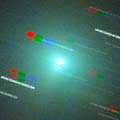
|
It reached to 7.2 mag on July 14 (Maik Meyer), then it faded down to 9.0 mag on Aug. 13 (Carlos Labordena). Although it had been unobservable for a while, now it is observable again. In the Southern Hemisphere, it keeps observable while fading gradually. In the Northern Hemisphere, it will be fading while keeping extremely low.
Date(TT) R.A. (2000) Decl. Delta r Elong. m1 Best Time(A, h)
Dec. 22 11 5.33 -46 49.7 2.209 2.283 81 14.7 5:06 ( 0, 8)
Dec. 29 10 43.90 -48 18.0 2.176 2.367 88 14.9 4:17 ( 0, 7)
|
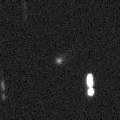
|
Now it is 15.9 mag (Sept. 8, Ken-ichi Kadota), brightening as expected. It will reach to 13.5 mag in the southern sky in spring and summer. In the Southern Hemisphere, it keeps observable for a long time after this. But in the Northern Hemisphere, it keeps locating extremely low until January, and will be unobservable after that. Then it will be observable again at the end of 2008, when the comet will already fade down to 15 mag.
Date(TT) R.A. (2000) Decl. Delta r Elong. m1 Best Time(A, h)
Dec. 22 0 16.24 -47 12.3 3.152 3.065 75 14.9 18:23 ( 1, 8)
Dec. 29 0 18.23 -47 5.6 3.191 3.024 71 14.8 18:27 ( 7, 8)
|
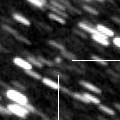
|
Now it is 15.8 mag (Sept. 2, R. Salvo). It keeps 15 mag for a long time until spring. Now it locates low even in the Southern Hemisphere, but it will be getting higher gradually after this. It moves in the southen sky, so it keeps observable in good condition in the Southern Hemisphere. It will never be observable again in the Northern Hemisphere.
Date(TT) R.A. (2000) Decl. Delta r Elong. m1 Best Time(A, h)
Dec. 22 17 37.00 -64 44.9 3.866 3.196 41 15.0 5:33 (330,-32)
Dec. 29 17 45.93 -66 3.1 3.844 3.201 43 15.0 5:36 (332,-30)
|
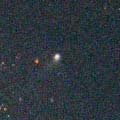
|
It was visible visually at 14 mag from spring to autumn in 2007. Now it is not observable. But it will be observable at 14 mag at high location again in 2008 spring.
Date(TT) R.A. (2000) Decl. Delta r Elong. m1 Best Time(A, h)
Dec. 22 17 4.63 0 32.8 6.452 5.596 27 15.1 5:33 (274, 6)
Dec. 29 17 6.81 0 58.4 6.410 5.595 31 15.1 5:36 (278, 12)
|
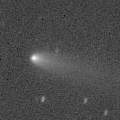
|
It reached up to 12.6 mag and was bright visually in autumn (Oct. 5, Seiichi Yoshida). Now it is fading, but it is still bright and visible visually at 14.0 mag (Dec. 9, Seiichi Yoshida). It keeps observable in good condition for a while after this. It will be visible visually for some more time.
Date(TT) R.A. (2000) Decl. Delta r Elong. m1 Best Time(A, h)
Dec. 22 0 29.42 -9 44.4 2.181 2.442 93 15.1 18:27 ( 0, 45)
Dec. 29 0 37.03 -8 38.6 2.282 2.459 88 15.3 18:27 ( 7, 46)
|
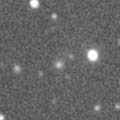
|
It was observed at 16 mag in 2007 spring and summer. Although it had been unobservable for a while, now it is appearing again in the Southern Hemisphere. It keeps 16 mag and observable in good condition after this until 2008 summer. In the Northern Hemisphere, it will never be observable again.
Date(TT) R.A. (2000) Decl. Delta r Elong. m1 Best Time(A, h)
Dec. 22 15 52.94 -44 11.8 3.460 2.688 32 15.2 5:33 (319, -9)
Dec. 29 16 11.77 -45 18.7 3.435 2.696 35 15.2 5:36 (321, -8)
|

|
Now it is 16.1 mag (Nov. 30, Ken-ichi Kadota), brightening as expected. It will reach to 13.5 mag from March to July, and will be visible visually. It keeps observable in good condition for a long time until May.
Date(TT) R.A. (2000) Decl. Delta r Elong. m1 Best Time(A, h)
Dec. 22 12 34.56 10 51.7 3.735 3.798 86 15.4 5:33 (326, 62)
Dec. 29 12 38.92 10 14.8 3.595 3.758 91 15.2 5:36 (340, 64)
|
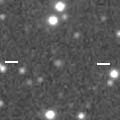
|
Now it is 15.6 mag (Nov. 24, Ken-ichi Kadota). Now it is not observable temporarily. But it will be getting higher in the morning sky after January. It will be bright at 12 mag for a long time from 2008 spring to 2009 spring. However, it is only observable until August in the Northern Hemisphere because the comet moves southwards. It keeps observable for a long time in the Southern Hemisphere.
Date(TT) R.A. (2000) Decl. Delta r Elong. m1 Best Time(A, h)
Dec. 22 17 25.69 2 48.0 5.096 4.247 27 15.3 5:33 (269, 3)
Dec. 29 17 31.06 2 2.8 5.029 4.196 29 15.2 5:36 (273, 8)
|
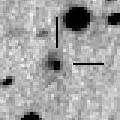
|
It is already bright as 14.3 mag and visible visually (Dec. 9, Seiichi Yoshida). It is expected to reach to 11 mag in 2009 summer. Because it moves in the northern sky, it keeps observable until it becomes brightest in the Northern Hemisphere.
Date(TT) R.A. (2000) Decl. Delta r Elong. m1 Best Time(A, h)
Dec. 22 4 44.38 64 12.1 5.192 5.954 137 15.5 22:40 (180, 61)
Dec. 29 4 28.29 64 2.7 5.174 5.906 134 15.5 21:57 (180, 61)
|
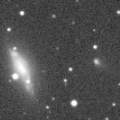
|
Now it is visible visually at 15.0 mag (Dec. 8, Seiichi Yoshida). It keeps observable in good condition until it fades out in spring.
Date(TT) R.A. (2000) Decl. Delta r Elong. m1 Best Time(A, h)
Dec. 22 1 58.75 44 42.7 1.220 1.978 127 15.7 19:57 (180, 80)
Dec. 29 2 5.02 44 17.3 1.280 1.993 122 15.8 19:35 (180, 81)
|

|
Peculiar asteroid moving on a cometary orbit. It was asteroidal at 18 mag in late August. It will reach to 15 mag in February and March. In the Northern Hemisphere, it keeps observable until July when it becomes fainter than 18 mag. It may show a cometary activity after this, although the perihelion distance is somewhat large as 1.8 A.U.
Date(TT) R.A. (2000) Decl. Delta r Elong. m1 Best Time(A, h)
Dec. 22 9 39.91 -28 51.8 1.292 1.819 105 16.2 3:40 ( 0, 26)
Dec. 29 9 48.04 -30 12.3 1.236 1.806 108 16.1 3:20 ( 0, 25)
|

|
Now it is 16.2 mag (Nov. 24, Ken-ichi Kadota). It keeps observable in the evening sky until March.
Date(TT) R.A. (2000) Decl. Delta r Elong. m1 Best Time(A, h)
Dec. 22 2 53.27 -22 2.8 4.084 4.601 116 16.2 20:50 ( 0, 33)
Dec. 29 2 50.98 -20 35.2 4.172 4.617 111 16.2 20:21 ( 0, 35)
|
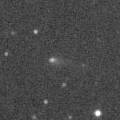
|
It brightened after the perihelion passage, and now it reached up to 14.1 mag and became visible visually (Dec. 8, Seiichi Yoshida). It will be observable in good condition for a while. But it can be fading rapidly after this.
Date(TT) R.A. (2000) Decl. Delta r Elong. m1 Best Time(A, h)
Dec. 22 2 38.11 5 3.7 1.435 2.187 128 16.2 20:36 ( 0, 60)
Dec. 29 2 40.37 6 7.1 1.517 2.206 122 16.4 20:10 ( 0, 61)
|
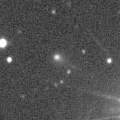
|
It was visible visually at 14.4 mag in autumn (Oct. 6, Seiichi Yoshida). But it will be fading gradually after this.
Date(TT) R.A. (2000) Decl. Delta r Elong. m1 Best Time(A, h)
Dec. 22 0 6.50 6 44.9 2.279 2.552 94 16.4 18:23 ( 9, 62)
Dec. 29 0 13.36 7 38.7 2.368 2.554 89 16.4 18:27 ( 22, 61)
|

|
Now it is 16.8 mag (Nov. 23, Ken-ichi Kadota), brightening as expected. It keeps observable at 16.5 mag in good condition for a long time until April.
Date(TT) R.A. (2000) Decl. Delta r Elong. m1 Best Time(A, h)
Dec. 22 12 7.19 3 38.8 1.872 2.106 89 16.4 5:33 (344, 58)
Dec. 29 12 16.38 3 9.5 1.811 2.123 94 16.4 5:36 (354, 58)
|

|
It will reach to 15 mag in 2009 and 2010. Now it is 17.3 mag (Nov. 4, J. A. Henriquez). It will be observable at 16.5 mag in good condition until March.
Date(TT) R.A. (2000) Decl. Delta r Elong. m1 Best Time(A, h)
Dec. 22 5 2.80 23 13.7 3.060 4.025 167 16.5 22:59 ( 0, 78)
Dec. 29 4 58.09 23 14.6 3.083 4.017 159 16.5 22:27 ( 0, 78)
|
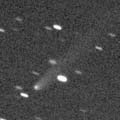
|
It was observed visually as bright as 13 mag from late 2005 to early 2006. Now it is fading. It is appearing in the morning sky again. It will be observable in good condition at 17 mag for a long time until June.
Date(TT) R.A. (2000) Decl. Delta r Elong. m1 Best Time(A, h)
Dec. 22 14 15.27 0 23.8 7.360 6.907 59 16.7 5:33 (304, 39)
Dec. 29 14 18.25 0 6.2 7.294 6.940 65 16.7 5:36 (311, 43)
|

|
It will pass 0.85 A.U. from the sun in late June in 2008, and it is expected to reach to 6 mag. In the Northern Hemipshere, it keeps observable in good condition for a long time after this, while the comet is brightening gradually. The comet will be 14 mag in February and become visible visually. Then it is observable until around May 25, when the comet will be 7.5 mag. It will be unobservable for one and a half month around the perihelion passage. But it will appear in the morning sky again at 7 mag in early July, then it keeps observable after that while the comet is fading gradually. In the Southern Hemipsphere, it keeps observable all the period until the comet fades out, although it will be low in mid June.
Date(TT) R.A. (2000) Decl. Delta r Elong. m1 Best Time(A, h)
Dec. 22 12 15.03 -3 46.8 2.890 2.966 84 17.0 5:33 (344, 50)
Dec. 29 12 20.90 -4 41.9 2.707 2.882 90 16.8 5:36 (353, 50)
|

|
It will reach to 15.5 mag in 2008 autumn and will be observable in good condition. In this winter, it is observable at 17 mag in good condition until March.
Date(TT) R.A. (2000) Decl. Delta r Elong. m1 Best Time(A, h)
Dec. 22 6 18.81 2 35.0 3.019 3.951 158 16.9 0:20 ( 0, 58)
Dec. 29 6 3.68 3 1.6 2.984 3.917 158 16.8 23:32 ( 0, 58)
|

|
It will be observable at 17 mag in good condition until February.
Date(TT) R.A. (2000) Decl. Delta r Elong. m1 Best Time(A, h)
Dec. 22 9 30.37 25 11.2 1.676 2.446 131 17.0 3:31 ( 0, 80)
Dec. 29 9 30.46 26 43.0 1.640 2.468 139 17.0 3:03 ( 0, 82)
|
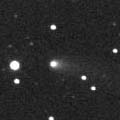
|
It reached to 13.5 mag and became visible visually in 2005 and 2006. Now it has gone far away. But the fading has been slower than predicted, and it is still bright as 16.3 mag (Nov. 7, Ken-ichi Kadota). It will be observable in good condition until February, and will keep 16-17 mag.
Date(TT) R.A. (2000) Decl. Delta r Elong. m1 Best Time(A, h)
Dec. 22 1 41.68 6 41.4 3.767 4.295 116 17.1 19:39 ( 0, 62)
Dec. 29 1 41.87 6 55.9 3.882 4.309 109 17.2 19:12 ( 0, 62)
|

|
It will reach to 13 mag in 2010. Now it is around the aphelion, but it will be observable at 17 mag in good condition in autumn and winter.
Date(TT) R.A. (2000) Decl. Delta r Elong. m1 Best Time(A, h)
Dec. 22 9 1.66 27 33.8 3.540 4.328 138 17.2 3:02 ( 0, 83)
Dec. 29 8 58.65 28 3.7 3.463 4.315 146 17.1 2:32 ( 0, 83)
|

|
Now it is 19.0 mag (Dec. 21, Luca Buzzi). It is expected to reach to 13 mag in March and April, and to be visible visually. It keeps observable in good condition for a long time in the Southern Hemisphere. In the Northern Hemisphre, it keeps locating low until March. But it will be getting higher after April and observable while the comet is fading.
Date(TT) R.A. (2000) Decl. Delta r Elong. m1 Best Time(A, h)
Dec. 22 11 11.72 -25 15.3 1.250 1.589 89 17.5 5:11 ( 0, 30)
Dec. 29 11 30.66 -28 3.0 1.159 1.535 91 17.2 5:02 ( 0, 27)
|
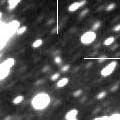
|
Now it is 17.5 mag (Nov. 25, Ken-ichi Kadota). Because it is distant object, it kept 17 mag for one year and a half. But it will be fading after this, and will be fainter than 18 mag in February.
Date(TT) R.A. (2000) Decl. Delta r Elong. m1 Best Time(A, h)
Dec. 22 2 29.79 17 19.3 3.783 4.490 130 17.4 20:27 ( 0, 72)
Dec. 29 2 29.40 16 19.7 3.909 4.527 123 17.4 19:59 ( 0, 71)
|

|
It will be observable at 17.5 mag in good condition until May.
Date(TT) R.A. (2000) Decl. Delta r Elong. m1 Best Time(A, h)
Dec. 22 8 34.25 27 21.8 3.398 4.239 144 17.4 2:35 ( 0, 82)
Dec. 29 8 31.96 28 38.5 3.329 4.223 152 17.4 2:05 ( 0, 84)
|

|
Now it is 18.3 mag (Dec. 14, Ken-ichi Kadota). It will be observable in good condition for a hile until spring. It will reach to 16.5 mag in March.
Date(TT) R.A. (2000) Decl. Delta r Elong. m1 Best Time(A, h)
Dec. 22 10 51.63 25 14.0 2.109 2.666 114 17.6 4:51 ( 0, 80)
Dec. 29 10 56.39 25 58.2 2.018 2.650 119 17.5 4:29 ( 0, 81)
|

|
It keeps 16 mag for one year from 2008 spring to 2009 spring. In the Northern Hemisphere, it keeps observable in good condition while the comet is brightening until 2008 spring. But the comet moves southwards after that, and it will never observable after 2008 July.
Date(TT) R.A. (2000) Decl. Delta r Elong. m1 Best Time(A, h)
Dec. 22 12 55.61 14 53.7 4.740 4.727 83 17.6 5:33 (312, 63)
Dec. 29 12 56.04 14 28.1 4.588 4.688 89 17.5 5:36 (327, 66)
|

|
It had been observed at 16.5 mag for a long time from 2005 to 2007. Now it is fading. But it keeps observable at 17.5 mag in good condition for a long time until July.
Date(TT) R.A. (2000) Decl. Delta r Elong. m1 Best Time(A, h)
Dec. 22 14 32.37 15 45.1 8.459 8.073 63 17.5 5:33 (284, 46)
Dec. 29 14 34.25 15 35.7 8.390 8.096 69 17.5 5:36 (290, 51)
|

|
Now it is 18.4 mag (Dec. 15, Ken-ichi Kadota). It will reach to 16 mag from February to April, and will be observable in good condition.
Date(TT) R.A. (2000) Decl. Delta r Elong. m1 Best Time(A, h)
Dec. 22 11 15.92 57 8.0 1.301 1.936 115 17.8 5:16 (180, 68)
Dec. 29 11 25.22 57 52.4 1.223 1.895 118 17.6 4:57 (180, 67)
|
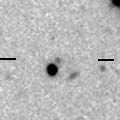
|
Now it is 17.8 mag (Nov. 18, Ken-ichi Kadota). It was observed at 17.5 mag in early 2007. It will be observable at 17.5 mag again in this winter.
Date(TT) R.A. (2000) Decl. Delta r Elong. m1 Best Time(A, h)
Dec. 22 11 12.35 -2 12.9 8.641 8.859 99 17.7 5:12 ( 0, 53)
Dec. 29 11 12.94 -2 6.1 8.533 8.864 106 17.6 4:45 ( 0, 53)
|

|
Now it is observable in good condition at 17.5 mag. But it will be fainter than 18 mag in January.
Date(TT) R.A. (2000) Decl. Delta r Elong. m1 Best Time(A, h)
Dec. 22 2 49.18 29 34.6 1.869 2.678 137 17.6 20:46 ( 0, 85)
Dec. 29 2 49.17 29 26.0 1.933 2.681 130 17.7 20:19 ( 0, 84)
|
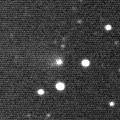
|
It was observed bright as 14-15 mag in 2004 and 2005. Now it is close to the aphelion, but it will be observable at 17.5 mag in good condition in 2007 autumn.
Date(TT) R.A. (2000) Decl. Delta r Elong. m1 Best Time(A, h)
Dec. 22 2 37.44 5 5.4 4.259 4.930 128 17.8 20:35 ( 0, 60)
Dec. 29 2 35.79 5 19.7 4.359 4.939 121 17.9 20:06 ( 0, 60)
|

|
Now it is 17.5 mag (Nov. 7, Ken-ichi Kadota). Now it is at maximum of brightness, but it keeps observable in good condition for a while after this.
Date(TT) R.A. (2000) Decl. Delta r Elong. m1 Best Time(A, h)
Dec. 22 3 15.52 -4 5.1 3.367 4.088 131 17.9 21:13 ( 0, 51)
Dec. 29 3 13.81 -3 30.7 3.440 4.089 125 17.9 20:43 ( 0, 52)
|
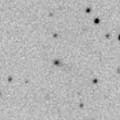
|
It was observed at 16.5-17 mag in last winter. It will be observable in good condition also in this winter. It should be 16 mag by calculation. However, it was so faint as 18.5 mag in autumn, much fainter than expected. It was observed so faint around the perihelion passage in the previous apparition at the discovery. So maybe it suddenly faded out before the perihelion passage again.
Date(TT) R.A. (2000) Decl. Delta r Elong. m1 Best Time(A, h)
Dec. 22 8 0.61 24 33.3 3.367 4.262 152 18.5 2:01 ( 0, 80)
Dec. 29 7 57.27 25 4.8 3.321 4.258 159 18.5 1:30 ( 0, 80)
|
|
![]()
 C/2007 F1 ( LONEOS )
C/2007 F1 ( LONEOS ) 29P/Schwassmann-Wachmann 1
29P/Schwassmann-Wachmann 1 93P/Lovas 1
93P/Lovas 1 C/2006 OF2 ( Broughton )
C/2006 OF2 ( Broughton ) C/2006 S5 ( Hill )
C/2006 S5 ( Hill ) 110P/Hartley 3
110P/Hartley 3 192P/2007 T3 ( Shoemaker-Levy 1 )
192P/2007 T3 ( Shoemaker-Levy 1 ) C/2006 VZ13 ( LINEAR )
C/2006 VZ13 ( LINEAR ) C/2006 U6 ( Spacewatch )
C/2006 U6 ( Spacewatch ) C/2006 K4 ( NEAT )
C/2006 K4 ( NEAT ) C/2005 L3 ( McNaught )
C/2005 L3 ( McNaught ) P/2007 H1 ( McNaught )
P/2007 H1 ( McNaught ) C/2006 V1 ( Catalina )
C/2006 V1 ( Catalina ) C/2007 B2 ( Skiff )
C/2007 B2 ( Skiff ) C/2007 G1 ( LINEAR )
C/2007 G1 ( LINEAR ) C/2006 W3 ( Christensen )
C/2006 W3 ( Christensen ) 50P/Arend
50P/Arend 2005 WY3
2005 WY3 C/2006 K1 ( McNaught )
C/2006 K1 ( McNaught ) 191P/2007 N1 ( McNaught )
191P/2007 N1 ( McNaught ) 188P/2007 J7 ( LINEAR-Mueller )
188P/2007 J7 ( LINEAR-Mueller ) 70P/Kojima
70P/Kojima 74P/Smirnova-Chernykh
74P/Smirnova-Chernykh C/2003 WT42 ( LINEAR )
C/2003 WT42 ( LINEAR ) C/2007 W1 ( Boattini )
C/2007 W1 ( Boattini ) C/2007 U1 ( LINEAR )
C/2007 U1 ( LINEAR ) P/2007 T6 ( Catalina )
P/2007 T6 ( Catalina ) 117P/Helin-Roman-Alu 1
117P/Helin-Roman-Alu 1 65P/Gunn
65P/Gunn 26P/Grigg-Skjellerup
26P/Grigg-Skjellerup C/2006 M1 ( LINEAR )
C/2006 M1 ( LINEAR ) C/2007 T5 ( Gibbs )
C/2007 T5 ( Gibbs ) 180P/2006 U3 ( NEAT )
180P/2006 U3 ( NEAT ) C/2007 M2 ( Catalina )
C/2007 M2 ( Catalina ) C/2002 VQ94 ( LINEAR )
C/2002 VQ94 ( LINEAR ) 124P/Mrkos
124P/Mrkos C/2007 D1 ( LINEAR )
C/2007 D1 ( LINEAR ) P/2007 V1 ( Larson )
P/2007 V1 ( Larson ) P/2004 F3 ( NEAT )
P/2004 F3 ( NEAT ) 179P/2006 U2 ( Jedicke )
179P/2006 U2 ( Jedicke ) 173P/2005 T1 ( Mueller 5 )
173P/2005 T1 ( Mueller 5 )![]()



























